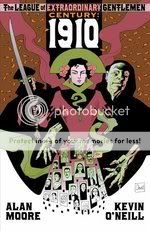The League of Extraordinary Gentlemen Vol. 3: Century #1: 1910
Alan Moore, writer
Kevin O’Neill, artist
Top Shelf/Knockabout, May 2009
80 pages
$7.95
Vastly more straightforward–and more like previous League of Extraordinary Gentlemen volumes–than its predecessor Black Dossier, Century: 1910 is a funny, creepy, nasty piece of work that encapsulates and articulates many of Alan Moore’s most heartfelt themes as explicitly and entertainingly as any book he’s ever done. (And he’s usually pretty explicit about that sort of thing, so that’s really saying something!)
Taking the rejiggering of the League’s line-up that occurred during the centuries-long sweep of Black Dossier‘s meta-story as read, 1910 joins Mina Murray, the rejuvenated Allan Quartermain, and their new teammates–the immortal gender-bender Orlando (currently male and generally going by Lando, making me want to say “Hello, what have we here?”), the gentleman thief Raffles, and the psychic detective Carnacki–as they attempt to thwart…something. They’re not quite clear on what it is, and base their investigation on little more than Carnacki’s ominous visionary nightmares. It could have something to do with the female heir to Captain Nemo, or with Jack the Ripper/Mack the Knife, or with a cult run by the sinister magus Oliver Haddo–they just know it’s gonna be bloody. Given Moore’s frequent depiction of the early 20th Century as the birthing of the proverbial rough beast, you can be pretty sure it’s gonna be bloody too.
What’s neat about this issue is that it’s what we in the blog business refer to as a done-in-one; I assume all of the Century books will interlock to tell one long story, and indeed there are plenty of plot threads to pick up down the line, but this tells a pretty satisfying story all on its own. In a way, the set-up, or I suppose the execution, reminded me a bit of the aspect of Warren Ellis’s early Planetary issues that I liked, or of the ending to Watchmen: the League doesn’t figure out what’s going on until it’s all over but the shooting. Moore obviously doesn’t care much for heroism, and the League’s never really “saved the day” in the traditional sense, but here they almost may as well have not shown up. Meanwhile (here’s the explicit part) Moore uses one of his simplest plotlines in ages to establish a direct link between violent misogynist sexuality and the unbridled bloodlust that ended up consuming the entire world not once but twice in the ensuing decades. Vengeance is sweet for the character involved, and you can’t help but get a kick out of it alongside her, but it’s also pretty fucked up, and if anything the League (the male ones, at least–Mina manages herself okay) just make it worse.
Insofar as the climactic bloodbath is representative of the century to follow, this can be seen as pessimism or resignation–but we’ve read Black Dossier and seen Moore’s efforts to establish the League’s true “heroic” legacy as one of imagination and a way of life freed from the dour, anti-life conservatism of their military minders. The question, I suppose, is whether that hedonistic heroism will win out, or if it will only succeed by carving out a space for itself in the Blazing World beyond and allowing our world to head right down the terlet. I mean, I know how it worked out in reality, I’m just curious as to how Moore will slice it in this alternate one.
If that all sounds like really grim reading, I suppose it is, but like I said, it’s also quite a funny book. The constant foreshadowing of the final massacre is so ominous it actually makes you chuckle from time to time the way a scary movie would–not from comic relief, but just because on some level you know what’s coming and it’s kind of amusing how ugly you already know it’s going to get. On the League end of things, the ongoing “are they or aren’t they” business about the Mina/Quartermain/Orlando menage is a hoot, especially the almost Scott Pilgrim-y way it finally comes out into the open, with some angry words that leave half the group wondering what the hell just happened. Kevin O’Neill, whose work simply looks like nothing else on the racks, gets to cut loose with a dock’s worth of leering scoundrels and ne’er do wells, and later with their comeuppance. Moore even injects some meta right into the mainline, with a cameo character who correctly identifies everyone and everything in the book’s world as fictional–he refers to Haddo, an Aleister Crowley manqué, as “Crowley manqué,” and works in a reference to Harry Potter’s Platform 9 3/4 as the launching pad for “the Franchise Express.” The book ends with a visual gag that’s like a shot from The Birds as covered by Troma. I’ll admit to skipping the prose supplement as always (tl;dr), but for pete’s sake one of the characters in it captured Fletcher Hanks’s Stardust the Super-Wizard! The whole comic is entertaining as all get-out, and even if you suspect that things are ultimately going to end very badly for our heroes, or with them washing their hands of our sordid world and fucking each other in Never-Never Land for all eternity, you’ll want to stick around to see how they get there.
Tags: comics, comics reviews, Comics Time, reviews

